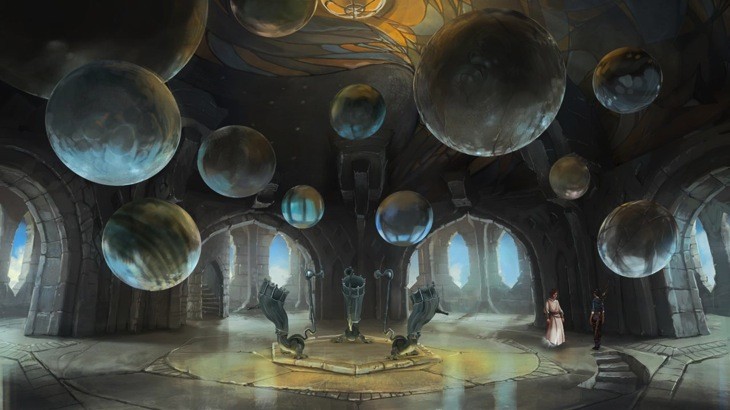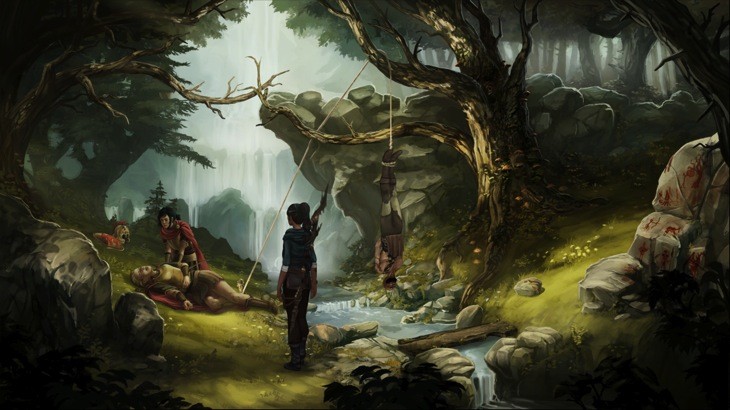
I sometimes wonder if we should call point and click adventures "games". They are the ultimate in linear story-telling, and yet they can be incredibly immersive and interesting. Memoria is a beautiful example of what point and click should be.
Memoria follows two interlinked stories, 450 years apart. The first is that of Geron, a young man who is seeking to save his love from a magical transformation that has turned her into a crow. Geron is considered a hero for actions that took place before the start of the story, and yet he seems to be more of a bumbling fool who gets sucked into a strange scenario. The other character is Sadja, an adventurous young woman determined to get revenge. She appears confident and stubborn, bending all other characters to her will. The game moves easily between the two characters, with pacing and action working seamlessly throughout. I was so immersed in the story, the last few hours of gameplay seemed to just fly by.
Geron’s story takes place in a magic-infused version of what I can only assume is meant to be an alternate version of dark ages Europe. His accent is vaguely English, but it’s not to say that the setting is actually the real world. Sadja’s story, on the other hand, takes place in a vaguely middle eastern/Babylonian setting, complete with arched doorways and racist depictions of violence.
Memoria is a point and click adventure, and in many ways sticks to the medium the way you would expect. Fill your inventory, combine items, rub them against things in the hope for progress. Unlike normal point and click adventures, most combinations and applications are fairly common sense. There are some places where you need to do things in an odd order, but for the most part the puzzles make sense – you use daggers to cut things open, or poke holes in small places, while sticks and ropes can be fashioned into animal traps.
However, Memoria adds an extra element in the way of spells. Each main character gains access to different spells – Geron can destroy or repair things, while Sadja gains a spell that can create visions to force NPCs to act in certain ways. These spells add an extra dimension to the typical point and click approach – it makes things a bit more tedious as it adds to the things you must rub together to try to make progress, but it also adds something other than inventory management to the experience.

What impressed me the most about Memoria was the aesthetic. Sure, the story was interesting and by the end I was pretty sucked in. However, the sound and art design was what truly held Memoria together.
First, there was the art direction. Each scene was beautifully drawn and created. The clickable elements blend naturally into the environment – no change in pigment or design. If players struggle to determine what can be clicked, they can simply press space and it will highlight the interactive points. In this way, the scenes are able to maintain artistic integrity without sacrificing ease of gameplay.

Next is the music and sound design. These are so important to creating a mood during point and click adventures. I still remember how the music in Myst shaped that game for me. Memoria is excellent in this regard – subtly crafting an ambiance without being overbearing. I particularly liked the sound effects as you would move or interact with different items. The voice acting was generally fantastic, although one or two characters were shockingly bad. Unfortunately, one of those characters is at the start of the game, which made me worry for the rest – that said, the majority of voice acting is well performed and suited to each character.
Finally, I was most impressed with the animation. Movements were fluid and natural, and the environment reacted to a wide range of influences. I particularly enjoyed the attention to water effects in various scenes – the game could have worked around any need for them, but instead revelled in the animations. Birds and animals were portrayed realistically, and the movements of characters and scenery were organic. I must say that this added to the immersion in a game that would otherwise be quite straight forward.
Depending on your ability with the puzzles, the game will take about eight hours to complete. Pretty decent value for a $20 game on Steam. You can check out my let’s play below:
Last Updated: October 14, 2013
| Memoria | |
|
If you are into interactive storytelling, or point and click adventures, Memoria sure is a beauty. Worth checking out, although you need to see the story through to the end to truly appreciate the characters.
|
|
|---|---|
| Memoria was reviewed on PC | |
|
| |





















Hammersteyn
October 14, 2013 at 15:47
Fortunately this wasn’t a horror game or Pew Die Pie’s Bro Army would have spammed the comment section.
Admiral Chief Ninja
October 14, 2013 at 15:59
XD
Purple_Dragon
October 14, 2013 at 16:31
Sounds good. I really miss the magic of the original Sierra games. Spent so many hours with Kings and Space Quests.
Blackhawk
October 14, 2013 at 20:58
Sounds like a Quest-for-Glory homage. Man, I miss those games….
Tiaan Pat
October 15, 2013 at 07:37
This actually looks cool.
Hesperus Phosphorus
October 16, 2013 at 14:07
Point-and-click games till death!